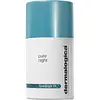What's inside
What's inside
 Key Ingredients
Key Ingredients

 Benefits
Benefits

 Concerns
Concerns

 Ingredients Side-by-side
Ingredients Side-by-side

Water
Skin ConditioningPropylene Glycol
HumectantGlycerin
HumectantAlcohol Denat.
AntimicrobialPEG/PPG/Polybutylene Glycol-8/5/3 Glycerin
HumectantHydroxypropyl Tetrahydropyrantriol
Skin Conditioning3-O-Ethyl Ascorbic Acid
Skin ConditioningPPG-6-Decyltetradeceth-30
EmulsifyingPhenoxyethanol
PreservativeSalicylic Acid
MaskingXanthan Gum
EmulsifyingHydroxyethylcellulose
Emulsion StabilisingPotassium Hydroxide
BufferingCitric Acid
BufferingSodium Citrate
BufferingTocopheryl Acetate
AntioxidantLavandula Angustifolia Oil
MaskingDisodium EDTA
Adenosine
Skin ConditioningLinalool
PerfumingButylene Glycol
HumectantTocopherol
AntioxidantCitrus Aurantium Tachibana Peel Extract
HumectantPaeonia Suffruticosa Root Extract
Skin ProtectingWater, Propylene Glycol, Glycerin, Alcohol Denat., PEG/PPG/Polybutylene Glycol-8/5/3 Glycerin, Hydroxypropyl Tetrahydropyrantriol, 3-O-Ethyl Ascorbic Acid, PPG-6-Decyltetradeceth-30, Phenoxyethanol, Salicylic Acid, Xanthan Gum, Hydroxyethylcellulose, Potassium Hydroxide, Citric Acid, Sodium Citrate, Tocopheryl Acetate, Lavandula Angustifolia Oil, Disodium EDTA, Adenosine, Linalool, Butylene Glycol, Tocopherol, Citrus Aurantium Tachibana Peel Extract, Paeonia Suffruticosa Root Extract
Water
Skin ConditioningCyclopentasiloxane
EmollientMethylheptyl Isostearate
Skin ConditioningButylene Glycol
HumectantDimethicone
EmollientCetyl Alcohol
EmollientIsohexadecane
EmollientCetearyl Alcohol
EmollientGlyceryl Stearate Citrate
EmollientCetearyl Ethylhexanoate
EmollientCetyl Caprylate
EmollientRubus Idaeus Seed Oil
EmollientVaccinium Macrocarpon Seed Oil
Skin ConditioningVigna Aconitifolia Seed Extract
Skin ConditioningStrelitzia Nicolai Seed Aril Extract
Skin ConditioningOligopeptide-34
Skin ConditioningLactobacillus/Pumpkin Fruit Ferment Filtrate
Skin ConditioningMagnesium Ascorbyl Phosphate
AntioxidantNiacinamide
SmoothingCananga Odorata Flower Oil
MaskingTocopherol
AntioxidantBeta-Sitosterol
Emulsion StabilisingZinc Glycinate
BufferingDecyl Glucoside
CleansingPolysilicone-11
Sodium Cocoyl Glutamate
CleansingDipotassium Glycyrrhizate
HumectantHydrogenated Phosphatidylcholine
EmulsifyingPotassium Cetyl Phosphate
EmulsifyingGlyceryl Caprylate
EmollientDimethicone Crosspolymer
Emulsion StabilisingDimethiconol
EmollientAcrylates/C10-30 Alkyl Acrylate Crosspolymer
Emulsion StabilisingAminomethyl Propanol
BufferingDisodium EDTA
Ethylhexylglycerin
Skin ConditioningPhenoxyethanol
PreservativeWater, Cyclopentasiloxane, Methylheptyl Isostearate, Butylene Glycol, Dimethicone, Cetyl Alcohol, Isohexadecane, Cetearyl Alcohol, Glyceryl Stearate Citrate, Cetearyl Ethylhexanoate, Cetyl Caprylate, Rubus Idaeus Seed Oil, Vaccinium Macrocarpon Seed Oil, Vigna Aconitifolia Seed Extract, Strelitzia Nicolai Seed Aril Extract, Oligopeptide-34, Lactobacillus/Pumpkin Fruit Ferment Filtrate, Magnesium Ascorbyl Phosphate, Niacinamide, Cananga Odorata Flower Oil, Tocopherol, Beta-Sitosterol, Zinc Glycinate, Decyl Glucoside, Polysilicone-11, Sodium Cocoyl Glutamate, Dipotassium Glycyrrhizate, Hydrogenated Phosphatidylcholine, Potassium Cetyl Phosphate, Glyceryl Caprylate, Dimethicone Crosspolymer, Dimethiconol, Acrylates/C10-30 Alkyl Acrylate Crosspolymer, Aminomethyl Propanol, Disodium EDTA, Ethylhexylglycerin, Phenoxyethanol
 Reviews
Reviews

Ingredients Explained
These ingredients are found in both products.
Ingredients higher up in an ingredient list are typically present in a larger amount.
Butylene Glycol (or BG) is used within cosmetic products for a few different reasons:
Overall, Butylene Glycol is a safe and well-rounded ingredient that works well with other ingredients.
Though this ingredient works well with most skin types, some people with sensitive skin may experience a reaction such as allergic rashes, closed comedones, or itchiness.
Learn more about Butylene GlycolDisodium EDTA plays a role in making products more stable by aiding other preservatives.
It is a chelating agent, meaning it neutralizes metal ions that may be found in a product.
Disodium EDTA is a salt of edetic acid and is found to be safe in cosmetic ingredients.
Learn more about Disodium EDTAPhenoxyethanol is a preservative that has germicide, antimicrobial, and aromatic properties. Studies show that phenoxyethanol can prevent microbial growth. By itself, it has a scent that is similar to that of a rose.
It's often used in formulations along with Caprylyl Glycol to preserve the shelf life of products.
Tocopherol (also known as Vitamin E) is a common antioxidant used to help protect the skin from free-radicals and strengthen the skin barrier. It's also fat soluble - this means our skin is great at absorbing it.
Vitamin E also helps keep your natural skin lipids healthy. Your lipid skin barrier naturally consists of lipids, ceramides, and fatty acids. Vitamin E offers extra protection for your skin’s lipid barrier, keeping your skin healthy and nourished.
Another benefit is a bit of UV protection. Vitamin E helps reduce the damage caused by UVB rays. (It should not replace your sunscreen). Combining it with Vitamin C can decrease sunburned cells and hyperpigmentation after UV exposure.
You might have noticed Vitamin E + C often paired together. This is because it is great at stabilizing Vitamin C. Using the two together helps increase the effectiveness of both ingredients.
There are often claims that Vitamin E can reduce/prevent scarring, but these claims haven't been confirmed by scientific research.
Learn more about TocopherolWater. It's the most common cosmetic ingredient of all. You'll usually see it at the top of ingredient lists, meaning that it makes up the largest part of the product.
So why is it so popular? Water most often acts as a solvent - this means that it helps dissolve other ingredients into the formulation.
You'll also recognize water as that liquid we all need to stay alive. If you see this, drink a glass of water. Stay hydrated!
Learn more about Water